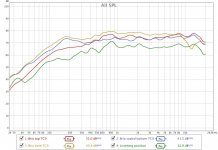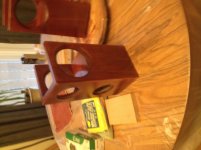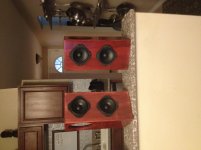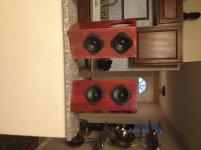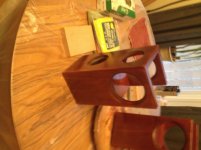The Betsy is a good driver, that has got some good reviews around here.
Ben, the driver I have is the TangBang W8-1772, a driver usually best for horn designs, but TB has the W8-1808, which is pretty much a copy of the 1772, but intended more for open baffle.
I plan to run my speakers in a FAST mode, using the bottom sub to 300Hz, and the 1772 over that.
I'm thinking of getting another woofer (not just sub), and use that in a similar design as the Brios, but with 8" drivers....
Ben, the driver I have is the TangBang W8-1772, a driver usually best for horn designs, but TB has the W8-1808, which is pretty much a copy of the 1772, but intended more for open baffle.
I plan to run my speakers in a FAST mode, using the bottom sub to 300Hz, and the 1772 over that.
I'm thinking of getting another woofer (not just sub), and use that in a similar design as the Brios, but with 8" drivers....
Here are the measurements of the Brio wannabe I made 🙂
DAC and amp were set with the initial sweep of the dipole driver, and left untouched for the other sweeps.
I see why the top one starts to get bypassed at 1k... probably helps flatten out that little bump right under 1k. That bump isn't there with the sealed driver.
Also, on close mic position (less than a meter), using both drivers, there is comb filtering happening peaking at about 13k.
This does not impact performance when sitting over 1.5m from the speaker though. So, I wouldn't use the Brios for a nearfield setup.
So, along with better imaging, having the speaker sitting away from walls, and the listener at least 1.5m away, the comb filtering is non-existent.
Having a sub (or two!) that will reach to 300Hz, and adding a little bit to the 300 to 500Hz range would make it just about perfect!
DAC and amp were set with the initial sweep of the dipole driver, and left untouched for the other sweeps.
I see why the top one starts to get bypassed at 1k... probably helps flatten out that little bump right under 1k. That bump isn't there with the sealed driver.
Also, on close mic position (less than a meter), using both drivers, there is comb filtering happening peaking at about 13k.
This does not impact performance when sitting over 1.5m from the speaker though. So, I wouldn't use the Brios for a nearfield setup.
So, along with better imaging, having the speaker sitting away from walls, and the listener at least 1.5m away, the comb filtering is non-existent.
Having a sub (or two!) that will reach to 300Hz, and adding a little bit to the 300 to 500Hz range would make it just about perfect!
Attachments
Hey all,
In ordering the cap for the 1000hz roll off do I calculate by 4 ohm load (combined load) or an 8 ohm load (individual driver load)??
Thanks
In ordering the cap for the 1000hz roll off do I calculate by 4 ohm load (combined load) or an 8 ohm load (individual driver load)??
Thanks
Connect your amp "+" and "-" to the bottom driver. Connect "-" of bottom driver to the "-" of the top driver. Connect one end of the cap to the "+" of the bottom driver and the other end to the "+" of the top driver.
Hi all. I am creating a prototype of these brio trio speakers as well. I already have one pair if the drivers and am getting the second pair soon. I am going to pair them with either an hsu subwoofer or an Eminence Alpha 15" in an h-frame. I wish that I could create a nice cabinet like the Nola ones.
I put a TC9 in a spherical enclosure and it sounds and measures great. I think it might be a tiny bit better than Fostex. Which would be amazing for $100 a pair. At $25 a pair, it's unheard of.
Similar to hypercube. Sounds very good but spherical cabinet gives a 1.3khz spherical mode resonance.
http://www.diyaudio.com/forums/full-range/265915-hyperfast-hypercube-based-2-way.html
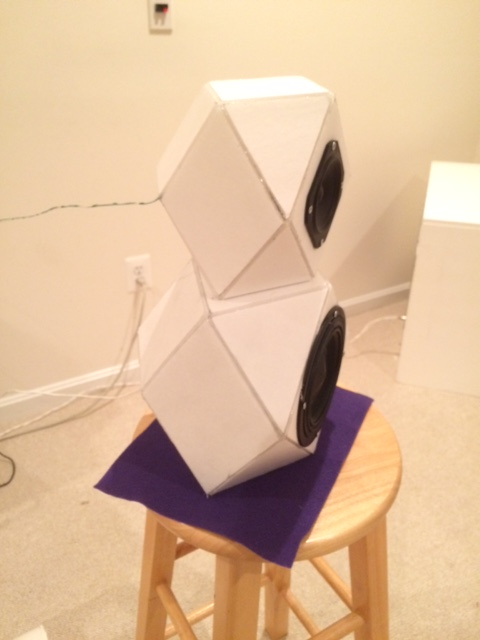
http://www.diyaudio.com/forums/full-range/265915-hyperfast-hypercube-based-2-way.html

😎
I plan on building it in a MLTL setup with a rear firing port located near the floor to increase bass output due to boundary gain. Hopefully the MLTL configuration will gain me a little lower f3 aswell.
any drawing or dimensions on a MLTL? Thanks!
Connect your amp "+" and "-" to the bottom driver. Connect "-" of bottom driver to the "-" of the top driver. Connect one end of the cap to the "+" of the bottom driver and the other end to the "+" of the top driver.
this contradicts the earlier post that says the cap should be on the + of the top driver...
how do i want to do this? Thanks

this contradicts the earlier post that says the cap should be on the + of the top driver...
how do i want to do this? Thanks
No, you connect both drivers in parallel, but for the amp to get to the top end driver it will "see" the cap in line. It's still on the + of the top driver.
No, you connect both drivers in parallel, but for the amp to get to the top end driver it will "see" the cap in line. It's still on the + of the top driver.
thanks.
(BTW .....Nice Signature line, Wesayso...)

this contradicts the earlier post that says the cap should be on the + of the top driver...
how do i want to do this? Thanks
There is no contradiction. Using the method I described you are connecting one end of the cap to the + of the amp and the other to the + of the top speaker. You're just using the + terminal of the bottom driver to make the connection. Sorry for the confusion.
Finally Finished
Well Guys here it is... The first prototype of the brio clone. Imaging is unreal, though I have never really had monitors/book shelve type speakers and I hear they tend to struggle less with good image. They come across as a bit bright and I wonder if it was my choice of cheap cap. Low end is almost non existent, though i didn't expect much. Good with jazz, vocals, acoustic but struggle with hard hitting low end and tend to distort a bit. I am making a second pair now out of MDF and will try a better cap to see if that solves the brightness and provide better tonal balance. Thanks again to one and all who gave advice and laughed at my pain!!!!!
Well Guys here it is... The first prototype of the brio clone. Imaging is unreal, though I have never really had monitors/book shelve type speakers and I hear they tend to struggle less with good image. They come across as a bit bright and I wonder if it was my choice of cheap cap. Low end is almost non existent, though i didn't expect much. Good with jazz, vocals, acoustic but struggle with hard hitting low end and tend to distort a bit. I am making a second pair now out of MDF and will try a better cap to see if that solves the brightness and provide better tonal balance. Thanks again to one and all who gave advice and laughed at my pain!!!!!
Attachments
- Home
- Loudspeakers
- Full Range
- Need help building open baffle/bass reflex hybrid
